acanthus; inlay; paliotto;
acanthus is a plant common in Mediterranean countries, the leaves of which were admired by the ancient Greeks for their elegance: their
conventional representation frequently decorated Greek and Roman works of art and later on those of Renaissance and Baroque artists.
inlay is a technique by which different types of wood, marble or other precious materials are used to form a picture.
paliotto is the decorated front of an altar.
The image shows the marble paliotto of the altar dedicated to S. Tommaso di Villanova in S. Agostino in Rome.
| 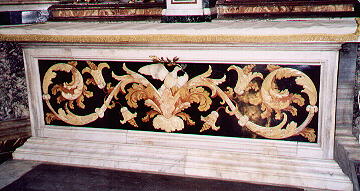 |
aedicule
aedicule (It. edicola) is a small temple usually having a circular or octagonal shape
used as a shrine for the statue of a god.
The term applies also to small circular chapels such as Cappella di Reginald
Pole.
By extension the term is used for a sort of small temple inserted by Baroque architects in the upper part
of the façade of a church.
The image shows the aedicule designed by Francesco Borromini for S. Carlo alle quattro fontane in Rome. | 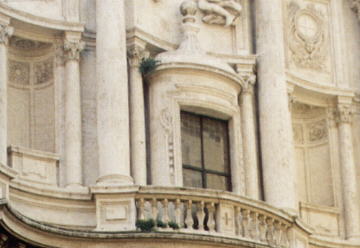 |
amorino; cupid; putto;
amorino, cupid and putto are terms used to design naked infant children, but amorino and cupid have small wings, while putto does not have them: cupid
in addition has bow and arrows.
The image shows to the left a cupid, at the center an amorino and to the right a putto. It is part of the decoration of Fontaine des Innocents in Paris.
|  |
apse
apse is the usually circular termination of the nave of a church. It derives
from the design of Roman basilicas (see Basilica di Massenzio).
In some churches the aisles have an apse too as
in this image of the cathedral of Anagni. | 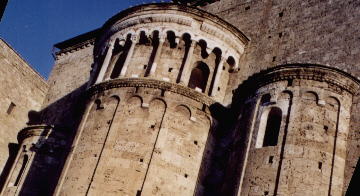 |
architrave; cornice; entablature; frieze; metope; triglyph
All these terms relate to the structure of Greek temples which became a cornerstone of ancient and modern architecture.
entablature
is the section of the temple between the columns and the roof and it is composed by:
a) the architrave (A) immediately above the columns;
b) the frieze (B)
containing the metopes (E), a series of rectangular reliefs separated by triglyphs (D), blocks with a uniform vertical decoration;
c) the cornice (C) immediately below the
roof.
Modern researchers and in particular George Hersey in The Lost Meaning of Architecture have associated the elements
of Greek temples with the sacrifices which took place in them.
The image shows the entrance of a house near Palazzo del Quirinale in Rome.
It is a mixture of styles: a Renaissance door is inserted in a classical frame while the metopes show the heraldic symbols (lamp, lion, eagle) of pope
Innocentius XI Odescalchi (1676-89).
| 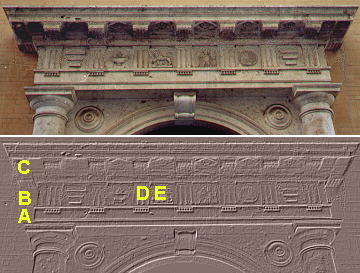 |
atlantes
Atlas, (It. Atlante) the leader of the Titans, defeated by Zeus,
was awarded an exemplary punishment, being ordered to carry the sky on his shoulders.
This mythological reference explains why a male figure
replacing a column or a pillar is called atlantes. Because Atlas was usually portrayed on his knees, a standing male figure is sometimes called telamon after Telamon, father of Ajax, who in the myth
built an altar to Heracles.
The image shows a detail of the decoration of the Theatre of Dionysius in Athens.
A female figure is called caryatid.
| 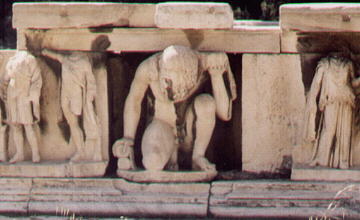 |
balustrade
balustrade: row of short pillars (balusters) with curved outline, used as a decorative parapet or
to separate a chapel from the rest of the church.
The image shows a balustrade in S. Giovanni in Laterano
designed by Francesco Borromini, characterized by the inversion of the balusters. | 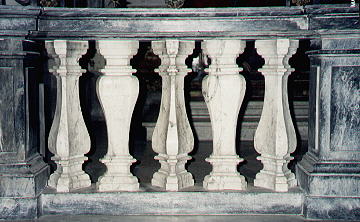 |
broken pediment
a pediment is the crowning of a portico or a façade, having
usually a triangular shape (tympanum). Broken pediments are typical of Baroque architecture.
The image
shows the broken pediment of Oratorio del SS. Sacramento in Rome. | 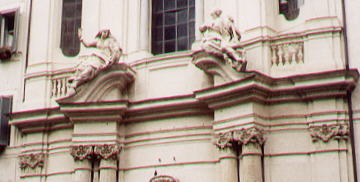 |
bucranium; festoon
bucranium is a Latin word meaning ox-scull: it was a typical decoration of the frieze
of classical temples, a clear reference to the sacrifices of oxen.
festoon: a garland of fruit and flowers.
A late Renaissance adaptation of these motifs can be seen in Palazzo del Laterano in Rome where the bucranium is replaced by a lion head and the garland is made of
pears (Lion and Pears being the heraldic symbols of pope Sixtus V who built the palace).
The image shows the decoration of Tomba di Cecilia Metella in Rome.
| 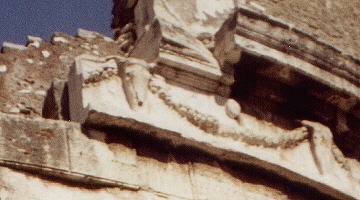 |
bugnato
bugnato is a typical decoration of
Renaissance Florentine palaces largely utilized again in the XIXth century.
The name refers to bugne large stones partly projecting from the walls.
The image
shows an early XXth century building decorated with bugnato by architect Gino Coppedè in Rome. | 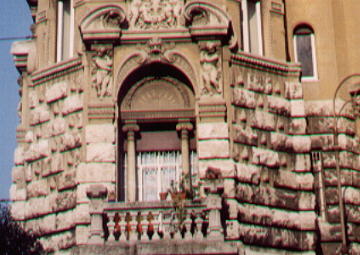 |


 or to
The Coats of Arms of the Popes or
to My Home Page on Baroque Rome or to
My Home Page on Rome in the footsteps of an XVIIIth century traveller
or to
The Coats of Arms of the Popes or
to My Home Page on Baroque Rome or to
My Home Page on Rome in the footsteps of an XVIIIth century traveller









